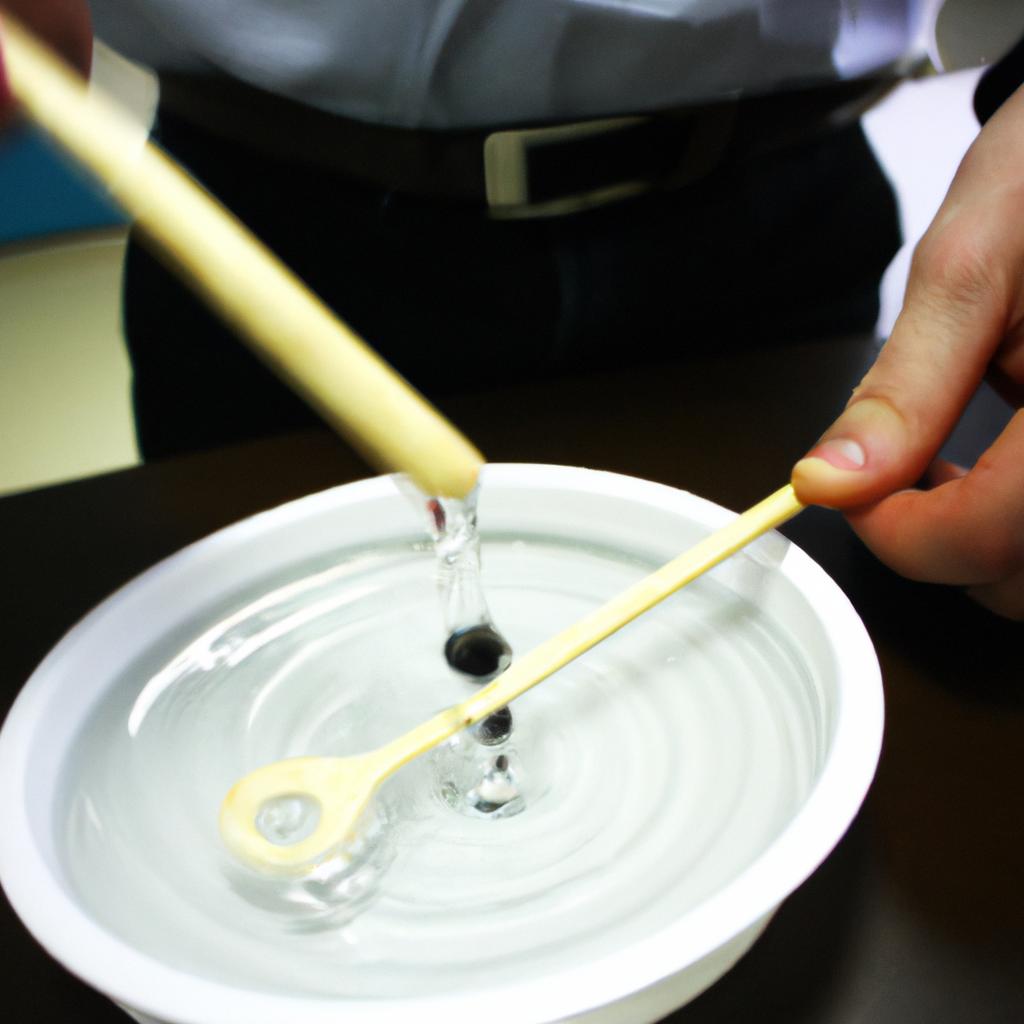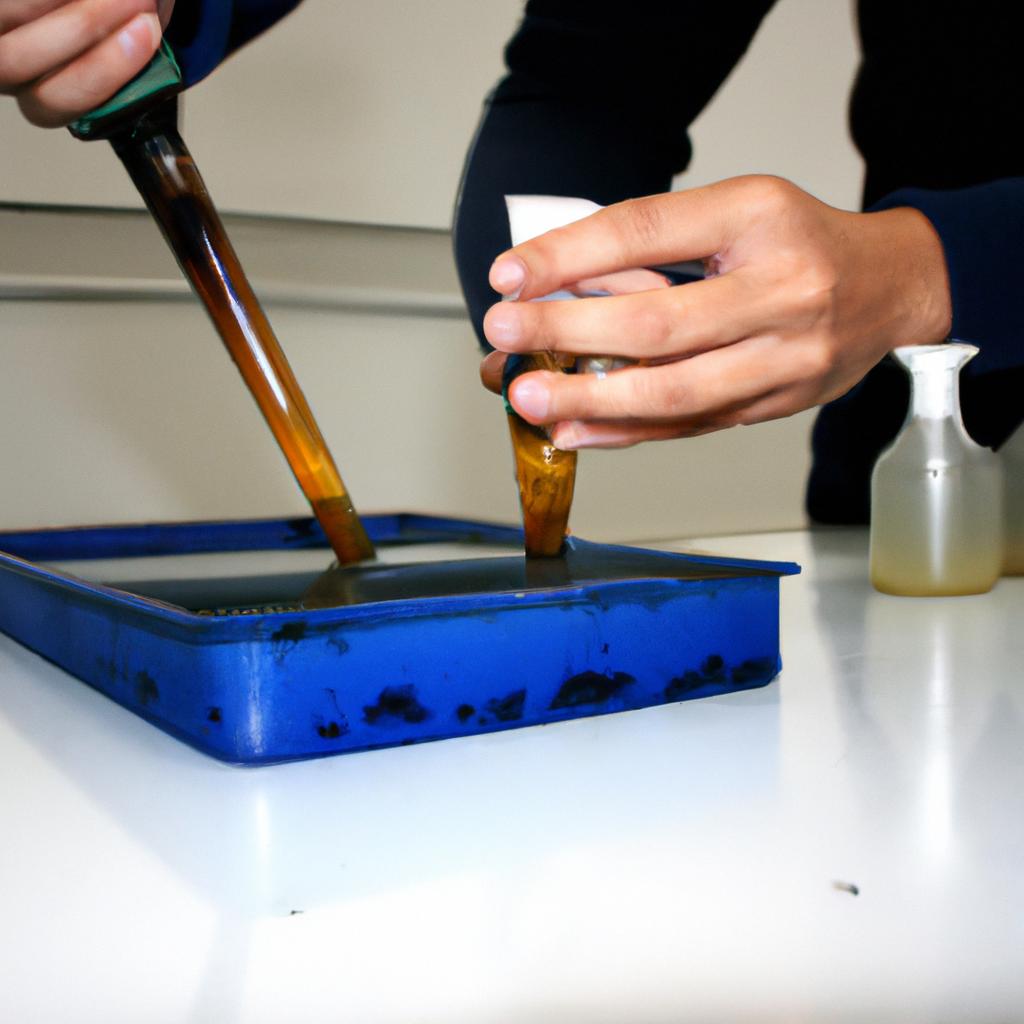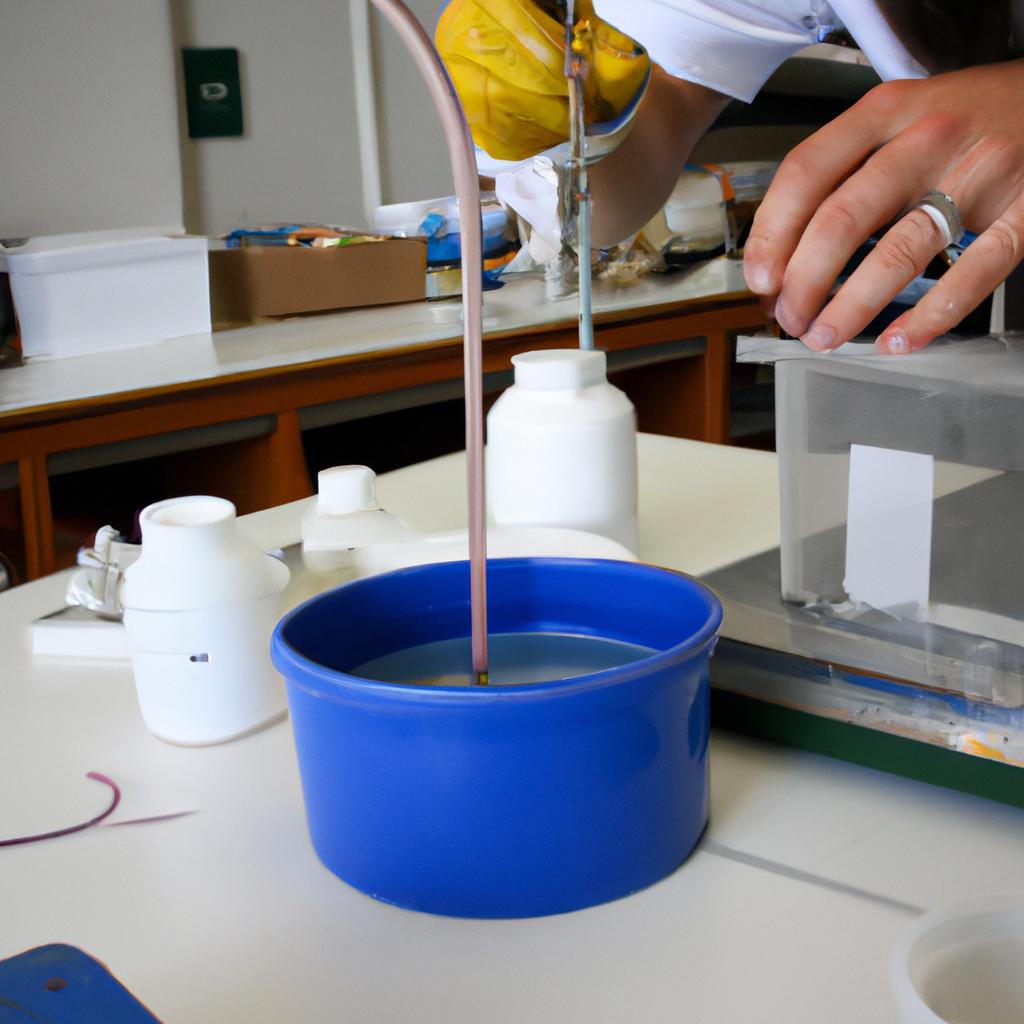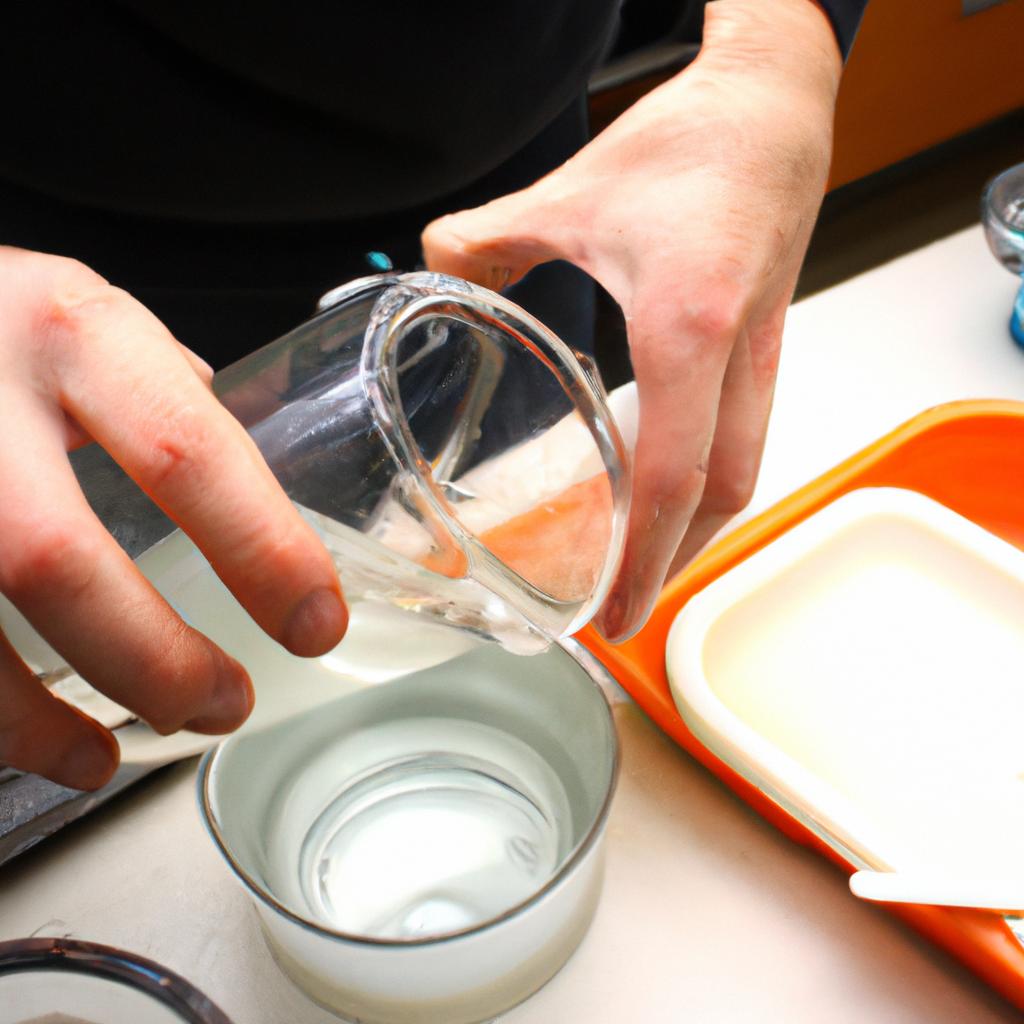Capillary Action and Floating: Fluid Mechanics

Capillary action and floating are fascinating phenomena in the field of fluid mechanics. These two concepts play a crucial role in understanding the behavior of fluids at both microscopic and macroscopic levels. Capillary action refers to the ability of a liquid to flow against gravity, defying its own weight, through narrow spaces such as capillaries or thin tubes. One intriguing example that exemplifies this phenomenon is when water rises up in a small glass tube placed vertically into a container filled with water. On the other hand, floating occurs when an object rests on the surface of a liquid without sinking due to buoyancy forces acting upon it. Understanding these principles has numerous practical applications ranging from medical science to engineering.
Exploring capillary action reveals intricate insights into how liquids behave under specific conditions. It is driven by cohesive and adhesive forces within the liquid itself and between the liquid and solid surfaces it comes into contact with. Cohesion is responsible for creating molecular attraction among similar particles while adhesion causes molecules of different substances to attract each other. In the case study mentioned earlier, water rises up in a vertical glass tube because adhesive forces between water molecules and the tube’s inner walls exceed cohesive forces within the water itself. This cohesive-adhesive imbalance leads to an upward movement known as This cohesive-adhesive imbalance leads to an upward movement known as capillary rise. The height to which the liquid rises is determined by the diameter of the tube and the surface tension of the liquid. Smaller tubes result in higher capillary rise due to increased adhesive forces.
Floating, on the other hand, relies on the principle of buoyancy. Buoyancy is a force exerted by a fluid on an object immersed or floating in it. It is directed upwards and equal to the weight of the fluid displaced by the object. When an object is less dense than the fluid it is placed in, it will experience an upward buoyant force greater than its own weight, causing it to float. This phenomenon can be observed with objects such as boats or even icebergs floating on water.
Understanding these principles has practical applications in various fields. In medicine, capillary action plays a role in processes like blood circulation and absorption of nutrients by cells. In engineering, knowledge of these phenomena helps design systems for transporting fluids through small channels or creating materials that repel liquids through superhydrophobic surfaces.
Overall, studying capillary action and floating provides valuable insights into fluid behavior and offers opportunities for innovation across different disciplines.
The concept of capillary action
The Concept of Capillary Action
Capillary action, also known as capillarity or wicking, is a fascinating phenomenon that occurs when liquids flow in narrow spaces against the force of gravity. To illustrate this concept, imagine a small glass tube inserted into a cup of water. Remarkably, the liquid level inside the tube will rise higher than the surrounding water level due to capillary action. This captivating occurrence has been studied extensively by scientists and engineers alike.
Understanding the underlying principles behind capillary action can shed light on various natural phenomena and practical applications. One example is the ability of plants to transport water from their roots up to their leaves through tiny vessels called xylem tubes. This process relies heavily on capillary action, enabling trees and other vegetation to draw water upwards against gravity and distribute it throughout their structure.
To further comprehend the significance of capillary action, consider its implications for absorbent materials such as sponges or paper towels. These everyday objects owe their exceptional absorptive properties to capillarity. When you spill a liquid onto a paper towel, for instance, it quickly spreads across its surface due to the combined forces of cohesion (water molecules sticking together) and adhesion (water molecules adhering to solid surfaces). The intricate network of microscopic channels within these materials facilitates rapid absorption, making them highly efficient tools for cleaning up spills.
In exploring the intricacies of capillary action, it is essential to recognize its key characteristics:
- Surface tension: A property resulting from intermolecular forces at the liquid-air interface.
- Meniscus: The curved shape formed at the boundary between a liquid and another material.
- Contact angle: The angle at which a liquid meets a solid surface.
- Capillary rise: The height to which a fluid ascends in response to capillary action.
By comprehending these features, researchers have harnessed capillarity’s power in areas ranging from microfluidics to medical diagnostics, with the potential for significant advancements in various fields.
Transitioning into the subsequent section about “How capillary action works,” it is crucial to delve further into these principles and mechanisms that enable this intriguing process.
How capillary action works
Capillary Action and Floating: Fluid Mechanics
Now let us delve deeper into how this intriguing process actually works.
To better understand the mechanics of capillary action, consider a scenario where you have a glass tube partially immersed in a container filled with water. As soon as the tube is inserted into the water, an upward force begins acting on the liquid column inside it. This force arises due to two primary factors: adhesive forces between the liquid molecules and the walls of the tube, and cohesive forces among the liquid molecules themselves.
One can observe several key elements that contribute to capillary action:
- Surface tension: The cohesive forces within a liquid cause its surface to behave like an elastic sheet. Surface tension plays a crucial role in facilitating capillary action by allowing liquids to maintain their shape and form menisci (curved surfaces) at their boundaries.
- Contact angle: When a liquid comes into contact with solid surfaces, it forms an angle known as the contact angle. The magnitude of this angle determines whether capillary rise occurs. If the contact angle is less than 90 degrees, indicating good wettability, capillarity will be observed.
- Tube radius: The diameter or radius of the tube significantly impacts capillary action. According to mathematical equations describing capillarity, smaller radii result in higher levels of ascent for liquids.
- Viscosity: Viscosity refers to a fluid’s resistance to flow. Liquids with lower viscosities tend to exhibit greater capillary effects compared to highly viscous fluids.
Table 1 showcases various examples illustrating how different substances interact when subjected to capillary action:
| Substance | Contact Angle | Capillarity |
|---|---|---|
| Water | < 90° | Rise |
| Mercury | > 90° | Depression |
| Alcohol | ~ 20-30° | Significant rise |
As we have seen, capillary action is influenced by a variety of factors. Understanding these parameters aids in predicting and controlling capillarity for practical applications such as ink absorption in paper or the movement of water through plant roots. In the subsequent section, we will explore the different factors that affect capillary action, shedding light on additional aspects to consider when studying this intriguing phenomenon.
[Transition sentence into next section: Factors that affect capillary action]
Factors that affect capillary action
Building upon our understanding of how capillary action works, let us now delve into the various factors that can influence this fascinating phenomenon.
Factors that Affect Capillary Action
Capillary action is not solely dependent on one factor; instead, several variables come into play. To illustrate, consider a scenario where two identical glass tubes are filled with water and inserted into containers containing different liquids – one tube submerged in oil and the other in an alcohol solution. The difference in liquid properties will result in varying degrees of capillary rise within each tube.
The following factors significantly impact capillary action:
- Surface Tension: The cohesive forces between molecules at a liquid’s surface create surface tension, which affects the height to which a liquid rises within a capillary tube.
- Tube Diameter: The diameter of the capillary tube plays a crucial role in determining the extent of capillary rise. Smaller diameters enhance rising heights due to increased adhesive forces between the liquid and solid surfaces.
- Liquid Properties: Different liquids possess distinct characteristics such as viscosity and density, affecting their ability to engage in capillary action.
- Gravity: While gravity generally opposes the upward movement of liquids through capillaries, its influence becomes negligible when the intermolecular forces responsible for capillarity are dominant.
To evoke a deeper emotional connection with our audience regarding these factors, let us take a moment to explore their significance through four key points:
- Surface tension: It is akin to an invisible force holding together liquid particles at the surface level, creating mesmerizing shapes like droplets or bubbles.
- Tube diameter: Even slight alterations in diameter can lead to significant variations in how far fluids can ascend against gravity, showcasing nature’s intricacies.
- Liquid properties: Each fluid has its own unique set of behaviors during capillary action – some race upwards effortlessly while others require more effort due to differences in molecular structure.
- Gravity: The constant reminder that forces of nature are always at play, either aiding or hindering the captivating properties of capillary action.
To further emphasize these factors and their effects on capillary action, let’s explore them in a tabular format:
| Factor | Effect on Capillary Action |
|---|---|
| Surface Tension | Determines liquid rise |
| Tube Diameter | Influences maximum height |
| Liquid Properties | Varies capillary behavior |
| Gravity | Opposes upward movement |
By understanding and appreciating these influential factors, we gain valuable insights into the intricate mechanisms underlying capillary action. In our next section, we will explore some practical applications where this phenomenon finds utility across different fields.
Having covered the various factors impacting capillary action, let us now turn our attention towards its wide-ranging applications.
Applications of capillary action
Factors That Affect Capillary Action
In the previous section, we explored the various factors that influence capillary action. Now, let us delve deeper into some of these factors and their effects on this fascinating phenomenon.
One example that highlights the impact of surface tension on capillary action is when water climbs up a narrow glass tube, defying gravity. This remarkable behavior occurs due to cohesive forces between water molecules, which create an adhesive force with the inner wall of the tube. The narrower the tube, the higher the water can climb against gravity, demonstrating how surface tension plays a crucial role in capillary action.
To better understand capillary action and its implications, consider the following four key factors:
- Tube diameter: The smaller the diameter of the tube or vessel in contact with a liquid, the greater the height to which it will rise.
- Liquid properties: Different liquids exhibit varying degrees of cohesion and adhesion forces, impacting their ability to undergo capillary action.
- Surface interactions: The nature of both solid surfaces and liquid interfaces influences how well they adhere to each other during capillary action.
- Gravity’s effect: Although capillary action can defy gravity by causing liquids to rise vertically in slender tubes, gravitational forces can still affect overall flow dynamics.
Let us now examine these factors more closely in a table format:
| Factor | Effect on Capillary Action |
|---|---|
| Tube Diameter | Smaller diameter leads to higher ascent |
| Liquid Properties | More cohesive and adhesive properties enhance capillarity |
| Surface Interactions | Improved interaction enhances upward movement |
| Gravity’s Effect | Can be overcome but affects overall flow dynamics |
Understanding these influential factors helps explain how fluids behave within confined spaces and provides insights into numerous practical applications across different fields.
The science behind floating lies in understanding buoyancy and fluid mechanics principles. In our next section, we will explore these concepts to gain a deeper understanding of why objects float or sink in liquids.
The science behind floating
Section H2: The Science behind Floating
Transitioning from the previous section on applications of capillary action, we now delve into the underlying science that explains why certain objects float while others sink. To illustrate this concept, let’s consider a hypothetical scenario where you place an ice cube gently onto the surface of a glass of water. As you observe, instead of sinking to the bottom, it floats effortlessly.
Understanding why objects like ice cubes float is intricately linked to fluid mechanics and buoyancy. When an object is submerged in a fluid, such as water, it experiences an upward force known as buoyant force. This force opposes the weight of the object and determines whether it will float or sink.
To further explore how buoyancy works, here are some key points:
- Buoyant Force: It is directly proportional to the volume of fluid displaced by the object.
- Archimedes’ Principle: An object will float if its weight is less than or equal to the weight of the fluid it displaces.
- Density Discrepancy: If an object has a lower average density than that of the fluid it is placed in (such as with ice floating in water), it will experience enough upward force due to buoyancy to remain afloat.
- Surface Tension: In addition to buoyancy, surface tension also plays a role in determining whether an object can float on a liquid’s surface. For example, small insects like water striders take advantage of surface tension to walk on water without sinking.
Table 1 summarizes these concepts visually for better comprehension:
| Concept | Explanation |
|---|---|
| Buoyant Force | Upward force exerted by fluids on submerged objects |
| Archimedes’ Principle | Object floats if its weight ≤ weight of displaced fluid |
| Density Discrepancy | Objects with lower average density than fluid can float |
| Surface Tension | Ability of liquids to maintain a cohesive surface layer |
As we move into the subsequent section about why certain objects float and others sink, it is important to note that understanding fluid mechanics and buoyancy allows us to analyze various phenomena in nature and engineering applications. Through this knowledge, scientists and engineers are able to design structures that harness these principles for practical purposes.
Transitioning smoothly into the next section, we will explore how factors such as density, shape, and weight distribution influence an object’s ability to float or sink. By unraveling these intricacies, we can gain a deeper appreciation of the physics behind floating objects.
Why certain objects float and others sink
Section H2: Why certain objects float and others sink
By exploring various variables such as density, buoyancy, and surface tension, we can gain a better grasp of why some objects effortlessly stay afloat while others succumb to gravity’s pull.
To illustrate these concepts, let us consider a hypothetical scenario where a wooden block and an iron ball are placed on the surface of water. The wooden block floats whereas the iron ball sinks. This discrepancy arises due to differences in their densities. Density measures how much mass is packed within a given volume; hence, if an object is less dense than the fluid it displaces (in this case water), it will float.
Buoyancy also plays a crucial role in determining whether an object floats or sinks. Buoyant force acts opposite to gravity and pushes upwards on submerged or partially submerged objects. It is equal to the weight of the fluid displaced by the object. If the buoyant force exceeds or matches the gravitational force acting on an object, it will experience an upward net force and thus float.
Furthermore, another phenomenon at play when considering floating is capillary action and surface tension. Surface tension occurs due to intermolecular forces between liquid molecules that create a “skin” effect at its surface. This cohesive force allows for capillary action –the ability of liquids to rise against gravity through narrow spaces like thin tubes– which explains phenomena such as water rising up in small gaps between two closely spaced solid surfaces.
In summary:
- Density determines whether an object will float or sink.
- Buoyancy opposes gravity and helps objects stay afloat when there is sufficient displacement.
- Surface tension facilitates capillary action, allowing liquids to defy gravity in confined spaces.
By unraveling these underlying principles, we gain a deeper appreciation for the intricate dynamics of floating and sinking. In the subsequent section, we will explore further applications and phenomena related to fluid mechanics.





